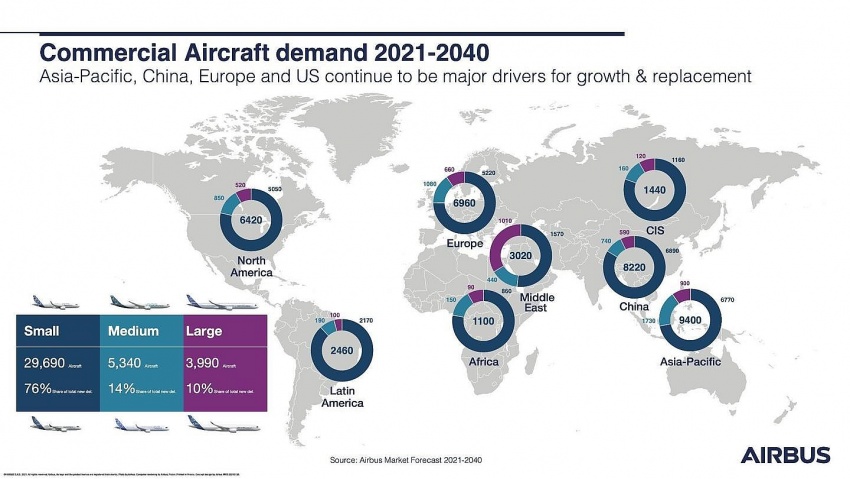Asia-Pacific region will need over 17,600 new aircraft by 2040
 |
This requirement is driven by passenger traffic growth of 5.3 per cent per annum and the accelerated retirement of older and less fuel-efficient aircraft.
“We are seeing a global recovery in air traffic, and as travel restrictions are further eased, the Asia-Pacific region will become one of its main drivers again,” said Christian Scherer, chief commercial officer and head of Airbus International.
“We are confident of a strong rebound in the region’s traffic and expect it to reach 2019 levels over the next three years. With an ever greater focus on efficiency and sustainable aviation in the region, our products are especially well positioned.”
In a region that is home to 55 per cent of the world’s population, China, India, and emerging economies such as Vietnam and Indonesia will be the principal drivers of growth in Asia-Pacific. GDP is expected to grow at 3.6 per cent per year compared to the world average of 2.5 per cent and double by 2040.
The middle class, who are the most likely to travel, will increase by 1.1 billion to 3.2 billion and the propensity for people to travel is set to almost triple by 2040.
Of the demand for aircraft, 13,660 are in the A220 and A320 groups. In the medium- and long-range categories, Asia-Pacific will continue to drive demand with some 42 per cent of global requirements. This translates to 2,470 medium and 1,490 large category aircraft.
Cargo traffic in Asia-Pacific will also increase at 3.6 per cent per annum, well above the global 3.1 per cent average, and will lead to a doubling in air freight in the region by 2040. Globally, express freight boosted by e-commerce will grow at an even faster pace of 4.7 per cent per year. Reflecting that strong growth over the next 20 years, there will be a need for some 2,440 freighters, of which 880 will be bought new.
Christian Scherer added, “Our modern portfolio offers a 20-25 per cent fuel burn, and therewith CO2 advantage over older-generation aircraft. We pride ourselves that all our products are already certified to fly with a blend of 50 per cent sustainable aviation fuel, set to rise to 100 per cent by 2030. In addition, our newly launched A350F offers efficiency gains of 10 to 40 per cent compared to any other large freighter, existing or expected, both in terms of fuel consumption and in CO2 emissions.”
Globally, in the next 20 years, there will be a need for some 39,000 new-build passenger and freighter aircraft, of which 15,250 will be for replacement. As a result, by 2040 the vast majority of commercial aircraft in operation will be the latest generation, up from 13 per cent today.
The global aviation industry has already achieved huge efficiency gains, as shown by the 53 per cent decline in CO2 emissions per revenue passenger kilometre since 1990.
Airbus’ product range supports at least a 20 per cent improvement in efficiency over previous-generation aircraft. In view of further ongoing innovations, Airbus has a clear ambition to achieve the air transport sector’s target to reach net-zero by 2050.
What the stars mean:
★ Poor ★ ★ Promising ★★★ Good ★★★★ Very good ★★★★★ Exceptional
Related Contents
Latest News
More News
- Vietnam’s industrial output hits seven-year high in 2025 (January 06, 2026 | 17:47)
- GELEX’s credit rating outlook upgraded to 'Positive' by VIS Rating (January 06, 2026 | 16:49)
- Finance sector lays firm groundwork for 2026 after major reform (January 06, 2026 | 15:30)
- Vietnam’s seafood exports surpass $11 billion in 2025 (January 06, 2026 | 08:51)
- Vietnam GDP posts second-strongest growth since 2011 (January 06, 2026 | 08:35)
- Double-digit GDP growth within reach with shift to higher-value expansion (January 06, 2026 | 08:33)
- Takeda Vietnam awarded for ongoing support of Vietnam’s sustainability efforts (December 31, 2025 | 21:00)
- Vietnam's retail market tops $269 billion in 2025 amid e-commerce boom (December 31, 2025 | 19:00)
- Stronger legal framework urged as trade fraud surges online (December 31, 2025 | 18:58)
- FPT exports first chip shipment to Japan (December 31, 2025 | 10:47)

 Tag:
Tag:























 Mobile Version
Mobile Version